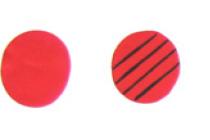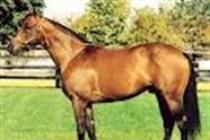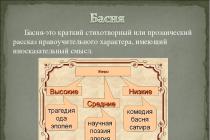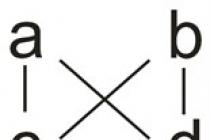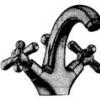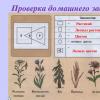Drawing is a very rewarding activity. In addition to being creative, it is based on many learning elements. Through a simplified drawing, the child learns the world, masters its colors, learns to hold a pencil and use a brush. This will help him in the future to develop hand motor skills, to creatively approach the development of literacy, drawing letters or numbers in the album. We will talk about how to learn to draw for children of 7 years old in this article.
At the end of the article we have prepared for you a checklist "Creative disorder in the apartment, how to control it!" Download it and you will not be afraid of children's creative experiments!
Drawing is a way of assimilating and transmitting information, mastered by man in ancient times. It is no coincidence that love for this type of creativity is genetically inherent and manifests itself at a very early age. All children are drawn to drawing. Usually, kids, imitating mom or dad, pick up a felt-tip pen or pencil and begin to guide them over the paper. This lesson helps to develop imagination, teaches elementary mathematical concepts, and forms taste.
For a child to learn to draw, you need to create suitable conditions for him.
Usually, by the age of 6-7, children already have a very well developed imagination. By this time, the child's urge to transfer his fantasies to paper increases. Your task is to provide him with the necessary tools and organize a place for drawing. It is very important that everything necessary for the creative process is in a place accessible to the baby. Inspiration can overtake children at any moment and, not finding its realization, quickly fade away.
In order for the process to go faster, you need to use for training pencil drawing method... Even if you don't know how to draw, you don't need to worry about it. Currently, there are many special children's albums, where there are a number of tasks that help a child and an adult master all stages of drawing, starting from the simplest ones.
For warm-up you can use simple exercise "Draw shapes in the air." This is a great way to stretch your hands. The next stage is "joint drawing", when the child holds a pencil, and mom or dad moves the baby's hand over the paper. In this way, you will teach your child to boldly draw simple shapes, as well as lines, and outline points. In the future, you can complicate the task by using the "paint the details" exercise. The final exercise can be the task "draw yourself".
- To teach a child to draw in pencil in stages, you need to explain to him which simple figures consists of a drawing, highlight the main elements and, together with the child, depict them separately, simplifying as much as possible.
- From the lines, make up the shapes that will serve as the basis for the drawing. Show your child how you can draw everything that surrounds you from simple lines.
A good workout can be coloring... With its help, children learn to hold a pencil confidently and not go beyond the lines. The child will also be able to independently select the necessary colors.
Be sure to praise your son or daughter, especially when they take the initiative.
There is no need to redo, "improve" the child's drawing, even if you do not like it. Your task is to support the child's aspiration for the creative process.
Let the children draw not only specific objects or animals, ask them to draw, for example, their emotions, moods or any fantasy.
Download the checklist "Creative disorder in the apartment, how to control it!"
Any mother knows what a "creative mess" is, it is useless to fight it. How can you help your child develop and at the same time spend less time cleaning? Follow the advice from the checklist and you will not be afraid of children's creative experiments!
Drawing is the most popular and rewarding creative activity in many families with young children. you can use different tools and materials, but I will focus only on how to teach children to paint correctly at home. After all, not everyone has the opportunity and time to take a child to an art studio. And they take there already trained children with ready-made skills. Here we will develop them on our own with our child.
Where to start?
First, you need your desire to work with the baby and his interest in the creative process. How to teach children to paint safely and with maximum benefit - this will be discussed in this article, based on personal experience drawing with children and grandchildren.
It is most convenient to use water-based paints, watercolors or gouache. Because they are perfectly cleaned from clothes and furniture, do not cause allergic reactions in children and are not toxic if swallowed, which often happens to the smallest artists. Agree that this is the most important argument in their favor.
Introduce your child to different tassels, preferably squirrel or pony tassels. They are inexpensive and very high quality, do not leave hairs on paper and do not roll during the arts of children who still do not know how to properly hold a brush and make movements with strokes.
Choose thick paper. Such. Like drawing sheets and A3 size. Do not spare money at the initial stage and disappointment will bypass you and your children.
Many art teachers recommend purchasing special sippy cups and a palette. But my grandchildren and I do well with ordinary glass jars from under baby food, in which we collect water and a white plate instead of a palette.
Drawing with paints for children is best to start with learning how to hold the brush correctly in your hands and draw strokes with a dry brush on a sheet of paper. That is, first practice precise hand movements and brush pressure before using paints.
How to teach preschoolers to draw with paints
Drawing with paints and a brush for preschoolers begins with the choice of one color, at the discretion of the child. This will keep you interested in the process and will not seem difficult from the outset. Let the child first learn to draw curves and straight lines, closed contours, and also paint them. Here Emir draws circles with yellow paint and paints them over.
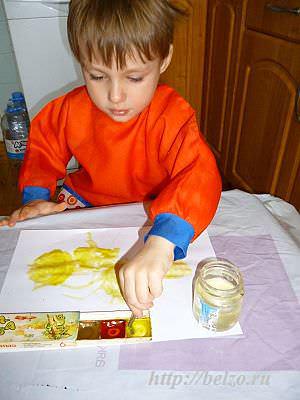
When working with liquid gouache, the kid must learn not to take excess paint with a brush, so that it does not drip or drip onto the paper. Important. So that the child knows how to properly rinse the brush in water, shake it off at the edge of the glass before using the paint. The grandson already understands that in order for the drawing to turn out bright, it is necessary to constantly dip the brush in water before each set of paint. On dry it turns out dirty and indistinct.
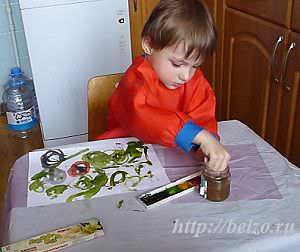
Many parents ask how to teach children to draw with paints. I would say that this is not an entirely correct question. You need to learn to draw with one paint long enough until the strokes and lines are neat. Only then introduce paint of a different color, also of your child's choice.
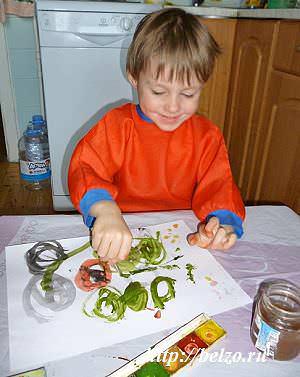
Don't be afraid if he chooses black. Using his example, it will be easier for a child to understand the need to often change the water in a glass and constantly wash the brush when changing color. Otherwise the paint will become dirty. But accuracy in drawing with paints must be taught immediately and without fail.
Emir and I were preparing, but we decided to draw the main character ourselves. I helped my grandson to decorate the cheeks and mouth, but he will do the cheeks and eyebrows himself.
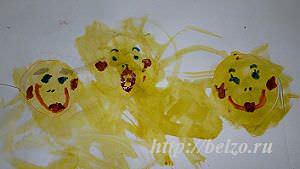
I want to warn parents right away that they do not expect clear and accurate movements from their baby when introducing the second color immediately. Everything will come gradually, because it is difficult for a small child to do several things at the same time. If you continue to reinforce the correct skills, then accuracy in the drawings will return.
Drawing objects for children of three summers is very difficult. Most likely, their drawings will be chaotic and dissimilar. But children develop imagination, fine motor skills of hands, observation and hone accuracy and accuracy.
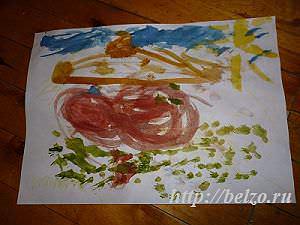
If you want to complicate drawing for your child, then invite him to draw show jumping in one color, and paint it in a second color. Summing up, I will draw your attention to several important points in teaching children to paint with paints at the very initial stage:
1.Kids can paint correctly with a brush
2. Learn to rinse the brush thoroughly before using new paint
3.Never mix two colors in the picture
4.Do not smudge paint with each other in the package
5. Draw closed lines and paint inside the path
6.Try to work carefully, not staining everything around, and not spilling water on the table
You can watch a video of how Emir behaves when changing colors
Do not scold children if they make a mess. But you must always remove it with your child. Have him wipe up spilled water with a rag himself. Washes out paints if they are all smeared while painting. And only after that he rests. This is not so tedious procedure as to feel sorry for the baby and clean everything herself. So it will go on for a long time. But that's up to you. Occupational therapy has not harmed anyone yet, but the brain develops perfectly.
Do not forget to cheer the children up, praise them for. It's a great idea to sign the child's drawings and put a date, so that later together you can observe the progress in the classroom every year.
Today I focused on how to teach children to paint at the age of two or three.
If this topic is interesting to you, and you are ready to find out the sequel, write about it in the comments. I plan to write about how to teach children to draw with paints from six months to two years old and about the basic drawing techniques. So, don't miss it. Stay with us.
A child develops every minute from birth. The mother's natural desire is to help the baby in his endeavors. Drawing is a great way to prepare your baby for preschool education.
When to start?
You can instill a love of drawing in babies from 9 months old, when they already sit well and confidently, giving them a brush in their hands or creating wonderful drawings with just their hands. At this age, the baby is very curious and learns the world with the help of tactile and taste buds. Bright paint cans will surely grab his attention. At this age, he will not create an ideal landscape, but the abstraction will certainly be bright and delight the crumbs. In this case, it is not the result that is important, but the very process of the child's acquaintance with the colors, their texture and capabilities. This will teach the kid to draw, as real artists do it. From a year old, or even earlier, you can give him a brush in his hands, colour pencils or felt-tip pens so that he can see the difference between colors.
Images with meaning, close to the general understanding of the drawing itself, the child begins to create after two years, closer to three. To develop artistic ability even earlier, direct interaction between parents and children is important. Mom should set an example, draw an object and voice out loud what she is doing and how. This will be a great start in order to teach your child to draw simple drawings.
First steps
Having decided to introduce the baby to paints, you need to be patient. To begin with, you need finger pigments. good quality... In any case, the baby will want to taste the new substance. Special finger paint are infused with a characteristic bitter taste so that there is no desire to eat them. You can draw in a regular album, but it is better to unfold a large Whatman paper or get a roll of old wallpaper. The more space is provided for the game, the less likely the surrounding objects will be stained. It is better to dress the child in household items that are not a pity to smear in paint.
After 3 years, even greater interest of children in drawings wakes up, they crave a variety of materials - paints, pencils, felt-tip pens, pens, crayons. It is necessary to give the little man the opportunity to develop his imagination, using various techniques. By combining a few simple elements, it is easy to teach a child to draw a person. As soon as he succeeds in drawing on his own, the tasks need to be gradually complicated. All classes should be conducted in a playful way, but in no case in the form of training sessions! If the kid is not in the mood, you should not force him through force - this will only make him alienate to creativity. 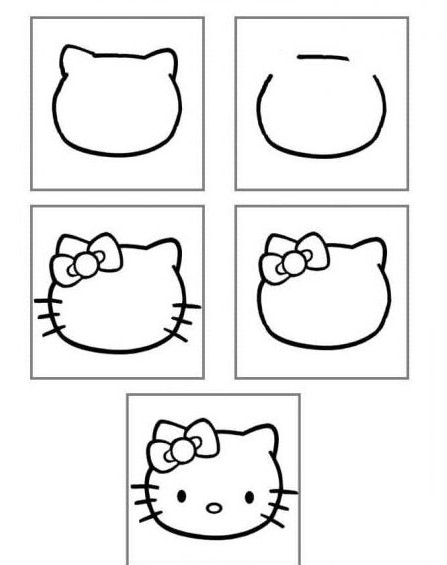
The simplest techniques for babies
To fully express emotions on paper, there are many different painting technique, the choice of which depends on the quality of the canvas, the shape of the brushes. In addition, the choice of tools determines how smoothly the paint will lie on the paper.
In addition to creative talents, drawing develops fine motor skills, speeds up the process of learning colors, develops horizons, sensing skills and an eye. Don't overload your baby. A pair of flowers on the palm is enough for the first acquaintance with drawing.
It's time to introduce the growing child to various techniques. Around a year, the baby is ready to pick up a brush and make a variety of strokes, strokes, lines. It is better to draw during the game. To do this, use cotton swabs, lids, a sponge and other materials at hand, with which you can truly show your imagination. There are a lot of options: splashing with a toothbrush, "printing" with a foam sponge or champagne cork, using applique elements and plasticine. 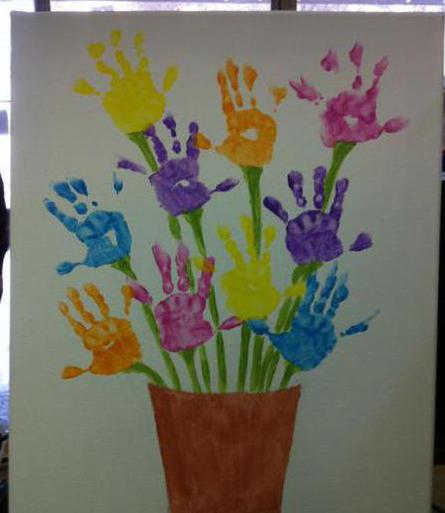
We draw with paints
It is better to start drawing classes with paints. They are bright, interesting consistency, you can paint with them without much effort. Children still have poorly developed fine motor skills, so they may not hold a brush or pencil, but create their masterpieces with their fingers.
Initially, when applying paint to a child's palm, it is important to monitor his reaction. The task of the parents is to help the child in an unfamiliar business. With palms and fingers, prints are first left on the Whatman paper. Ideally, if mom does the same. At first, three colors are enough. The lesson should end before the child gets tired, otherwise he may refuse to draw next time.
To develop motor skills, you can give your baby a cotton swab or sponge. The child should be interested in dipping an object into paint and getting different prints. In addition, the process itself develops not only fine motor skills, but also concentration of attention. 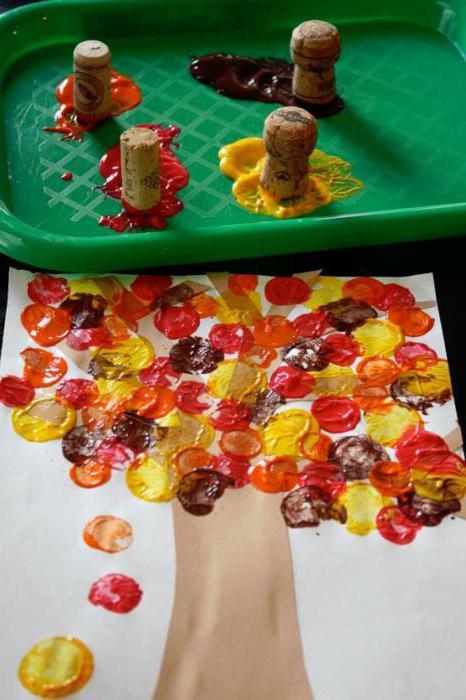
After a year and a half, acquaintance with figures, objects, animals begins. By combining elementary circles, squares and triangles, you can teach your child to draw simple drawings in stages, for example, a little man or animal faces.
Children's creativity with pencils
It is necessary to use a pencil to get acquainted with new drawing techniques - shading and outlining shapes. If the brush falls down with any pressure, then you need to make an effort to draw with a pencil.
The main condition for the development of a novice artist's creativity is to create optimal conditions. You can't interfere, you need to give the child freedom of action. Basically, the theme of creativity depends on his age. Younger children try to depict the sun, flowers. Older children try to draw princesses or cars. From the age of 5, full-fledged children's pictures already appear, the child begins to pay attention to details. He draws not only the main characters, but also the background.
Fine arts for toddlers
It is quite simple to interest a two-year-old, as well as to teach a child to draw at 3 years old. A personal example is needed. It is not enough to explain to the child how what is drawn, it is important to show it. The ideal time for classes is the first half of the day, when he does not want to sleep, eat and is still full of energy. The themes for the drawing are first determined by the mother. Most often these are ordinary lines, toys. The child will be interested in tracing the figures or connecting them in shading. Thus, he gets acquainted with the figures and trains to operate the pencil to the fullest, concentrating on his own actions.
As soon as the initial stage is passed, full-fledged simple drawings are made from the simplest elements learned. For teaching, soft triangular pencils are suitable. They contribute to the formation of the correct grip of the object in the hand. If you first give the child bright markers, later he may refuse to draw with pencils. 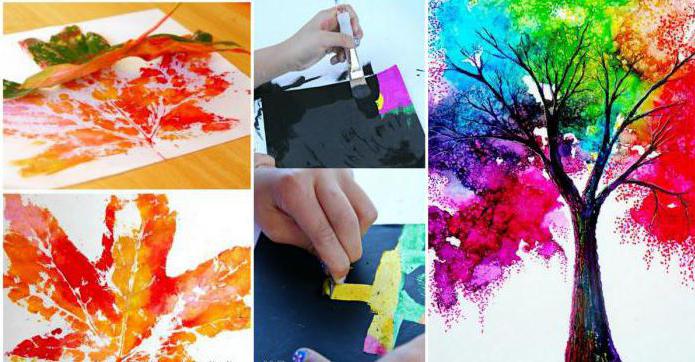
Elementary techniques for children
How to teach a child to draw simple drawings in stages? To begin with, it is important to know how they are created correctly.
To make the kid like to draw geometric figures, he should be interested in the task itself. If you just say "connect the dots", then there is a high probability of hearing a refusal. But "help the little dot catch up with the big one" or "connect mom-dot, dad-dot and baby-dot" is much more interesting. The child is more willing to take on this "mission".
In addition to the correct drawing technique, you need to pay attention to painting. For the first samples, shading is suitable. It is imperative to remind the child not to go beyond the boundaries of the picture. It is important that mom herself shows how the color changes and appearance drawn object if you press harder or lighter on the pencil. You can compare the drawings and ask the kid to explain what the difference is, to make sure that he understands the essence of the rules and the meaning of painting.
Drawing animals and humans
If parents expect to see a full-fledged portrait right away, then they will be disappointed. Initially, these can be schematic images of lines and geometric shapesperhaps not even connected to each other. The easiest way to teach a child to draw a person in stages is to use lines and a circle. Creating the desired image on paper, it is necessary to explain to the baby which part of the body this or that line is transmitting. If the lesson is given to the child with difficulty, it is worth asking him to cope with this task with joint efforts. 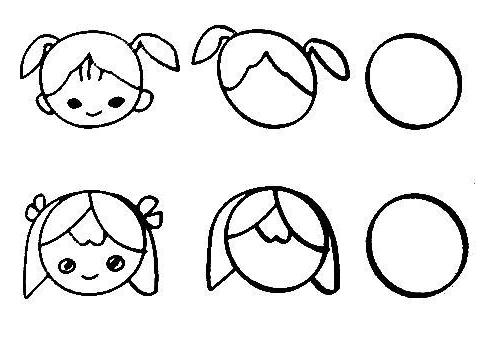
Creative activities with preschoolers
By the age of five, the child's imagination is actively developing. This gives him the opportunity to express his fantasies. Parents need to know how to teach a child to draw at 4 years old and convey their desires on a piece of paper. As mentors, they should help children to open up. At this stage, the child teaches:
- mixing rules for basic colors (red, yellow, blue);
- ways of sketching the background;
- criteria for combining several materials;
- the technique of making the drawings realistic.
You should not dictate your rules to your child. It is better to rush to the flight of his imagination, offering his ideas in the process. It is advisable to be close to your son or daughter at the time of creating the first drawings, so that children can voice their actions. Mom should ask leading questions that will help reveal the image and, possibly, require additional touches. In such an unobtrusive way, the imaginative thinking of the child develops, the vocabulary increases and oratory skills arise.
Full drawings
Having dealt with colors and shapes, the child will be able to draw on their own. He will be ready to depict not just figurines, but entire artistic compositions. If the mother regularly worked with the baby and was able to teach the child 4 years old to draw, as a rule, then he will get acquainted with various techniques on his own initiative. The main thing is to fuel his interest in this lesson. The kid should use various elements, details, sketch the background, learn to select shades, apply several techniques in one drawing (handprints and cotton swabs, tree leaf contours and splashes). As a result, you should get a full-fledged drawing with meaning. Let it be uncomplicated, and the objects - distorted or poorly painted. The main thing is the efforts and development of the baby. 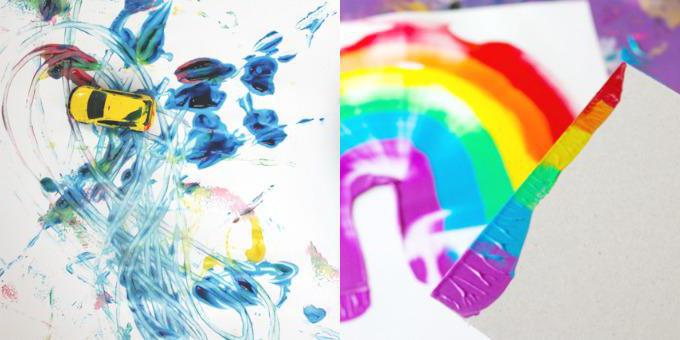
Most likely, the first drawings, which the mother gradually taught to draw a child of 4 years old, like the subsequent ones, will be devoted to nature or family members. Later, the kid himself will choose a theme for his work, trying to depict everything that he sees around.
What do children's pictures speak about?
The child's drawings, starting from the age of 4, convey his inner world. Children themselves are very impressionable. It is in the drawings that their main experiences are displayed. Psychologists often turn to this drawing technique to understand the state of mind of young patients. After all, the main thing is not how to teach to draw child 5 years old step by step, and then how to understand the meaning of his drawings. When translating his fantasies on paper, the baby is not limited, he can express what he is not able to say in words or show with gestures.
It is worth paying attention to what colors and shades the child usually chooses, what techniques he uses. It is important to determine the location of the main characters, their mood, what impression is left of the drawing as a whole. All this will help to feel the emotions of the child.
Art studios
Do not burden the smallest with additional activities. Parents' attention at home is quite enough. Only after 3-4 years can the child be sent to an art studio or circle, if the child has a craving for creativity.
At this age, it will be interesting for him to study on an equal basis with other children, he can imitate them and try to keep up. Classes are conducted in a playful way and do not overload the child's body at all, but only have a positive effect on its psychological state. As parents follow their leaders' advice, they should help their child develop their abilities at home.



